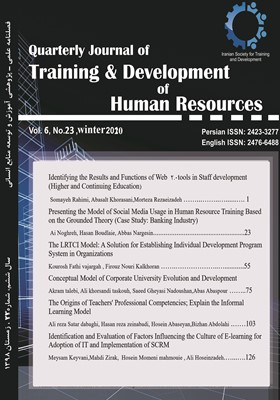-
-
List of Articles
-
Open Access Article
1 - Identification and evaluation of factors influencing the culture of E-learning for adoption of IT and implementation of SCRM
میثم کیوانی Mehdi Zrak hossein momeni mahmouei Ali Hosseinzadeh -
Open Access Article
2 - Conceptual Model of Corporate University evolution and development
Akram Talebi Saeed Ghiasi Nodooshan abbas abbaspour Ali khorsandi Taskooh -
Open Access Article
3 - Identify the results and functions of Web 2.0 tools in staff development (Higher and Continuing Education)
Somaye Rahimi Abasalt Khorasani Morteza Rezaeizadeh -
Open Access Article
4 - Emerging the Model of Social Media Usage in employee's training based on the Grounded Theory (Case Study: Banking Industry)
Hasan boudlaie ali noghreh abbas nargesian -
Open Access Article
5 - The origins of teachers' professional competencies; Explain the informal learning model
hasan reza zeinabadi Alireza Sattardabbaghi Hossein Abbasian بیژن عبدالهی -
Open Access Article
6 - The LRTCI Model: A Solution for Establishing Individual Development Program System in Organizations
Kurosh Fathi Vajargah Frouz Nouri
-
The rights to this website are owned by the Raimag Press Management System.
Copyright © 2017-2025







